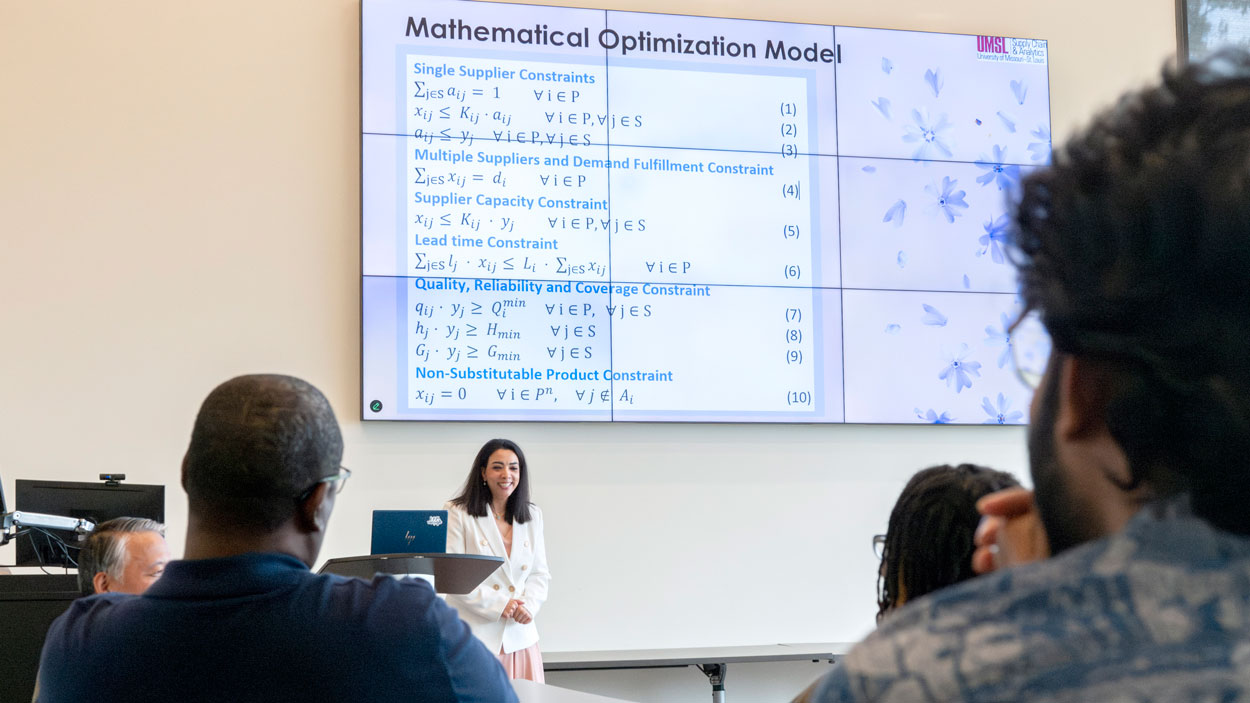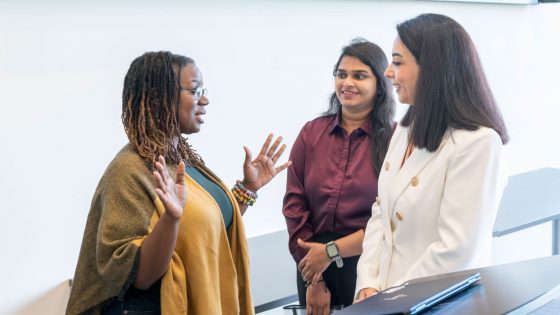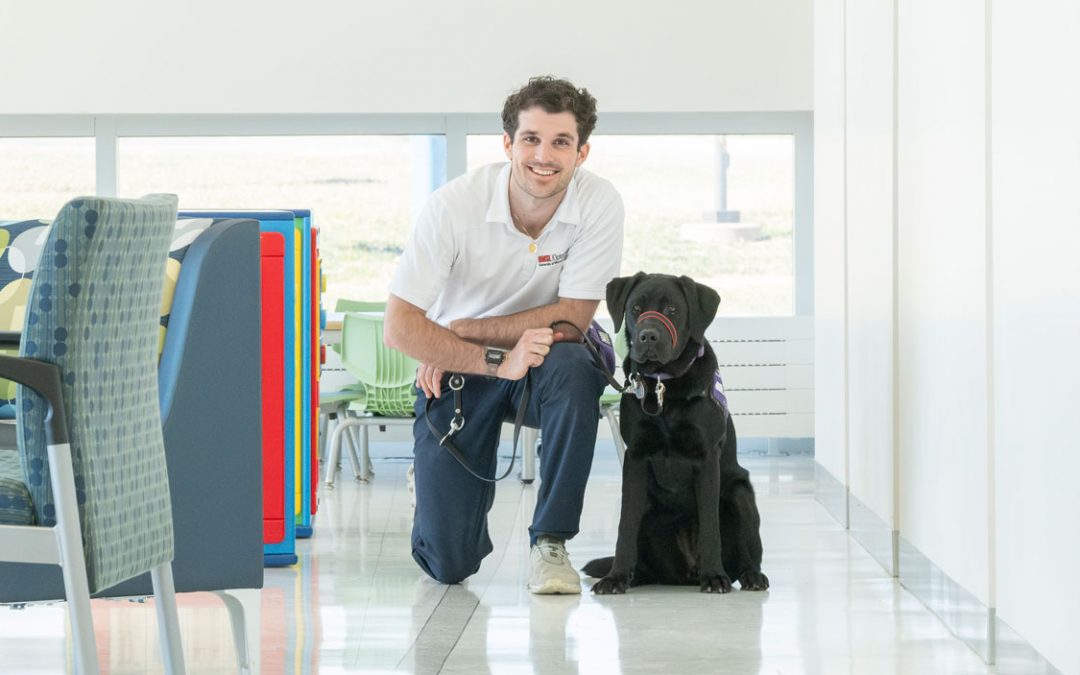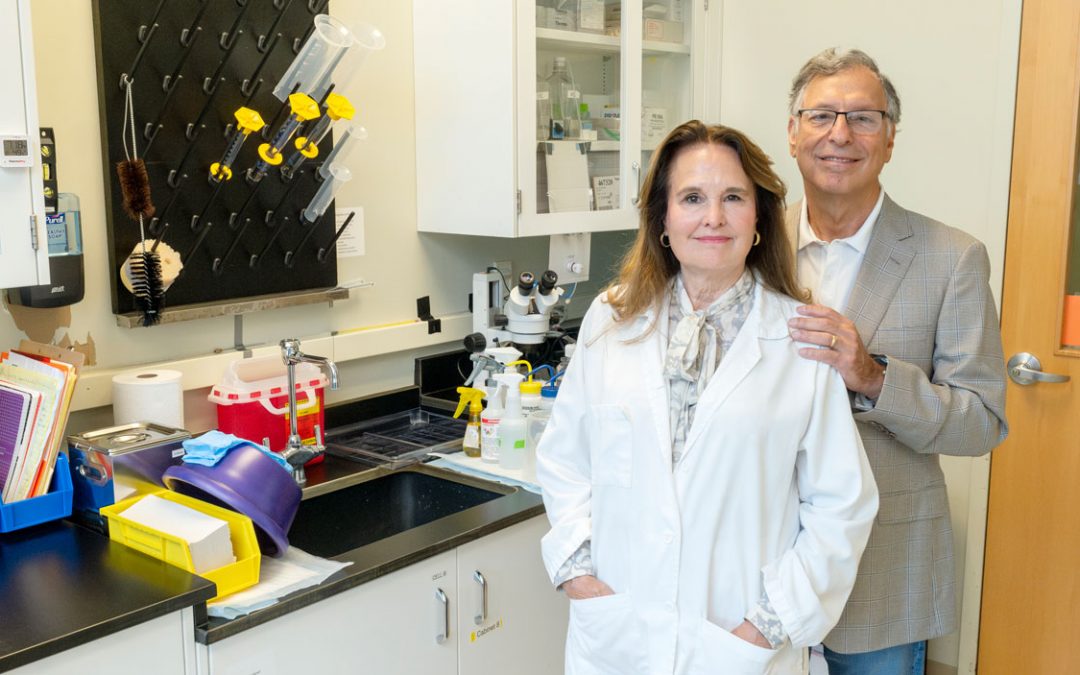
Zahra Rahmati presents the mathematical optimization model she developed with Sowmya Kumpatla to help Beauty Supply Refresh adjust its purchasing decisions in a volatile market. (Photos by Derik Holtmann)
One of the strengths of the Department of Supply Chain and Analytics at the University of Missouri–St. Louis is using current events to show how the knowledge and skills that students are learning in the program can be directly applied in real-world situations.
The reputation the department – not only in the St. Louis region, but across the United States – has earned is attracting the best and brightest to campus. For example, that’s why Zahra Rahmati, who was pursuing her doctorate at a different university, chose to adjust her plans and become part of UMSL’s program.
“I decided to transfer to here to do more practical analysis,” Rahmati said. “I was studying finance, and it was like more theoretical research, and I wanted to make an impact. I started classes in the fall, but this summer, I reached out to Dr. Haitao Li and asked, ‘Do you have something that is a hands-on experience that requires research?’”
Li, the Supply Chain department chair, had the perfect project for Rahmati. He connected her with Sowmya Kumpatla, who recently graduated from the Department of Information Systems and Technology who was also looking for a supply chain-related project.
Li had been helping Trinita Rhodes, the co-owner of Beauty Supply Refresh in Florissant, Missouri, understand and navigate the cost-related challenges related to rising tariffs. Rhodes had initially reached out to Li at the suggestion of Rashanda Jefferson, one of the beauty consultants at the store.
“We had started our ‘Tuesday Conversations’ on Instagram and Facebook, where I would just talk to our customers about how different topics were impacting us and what they needed to know,” Rhodes said. “We invited Professor Li to the store, so he could help me articulate a little bit better, give me some insight and really arm me with information on how I could communicate better to our audience about the tariffs.”
Not only did Li offer his insights, but he joined Rhodes for one of her Tuesday Conversations and even prepared a PowerPoint presentation. And then, he went one step above and beyond, suggesting that his department could help make a more direct impact by conducting data-driven research – pro bono – to optimize the store’s supplier selection decisions to adjust to a quickly changing marketplace.
“A project like this is an example of how we synergize and integrate our research talents and research expertise with our teaching and education,” Li said. “We have these talented, motivated students and the experience and expertise we have accumulated by our faculty over years. Plus, it’s about outreach and community engagement. We are making an impact that is so meaningful.”
After months of research and analysis, Rahmati and Kumpatla presented their findings to the Beauty Supply Refresh team – Rhodes, Jefferson and co-owner Wuan Davis – in Room 103 of Anheuser-Busch Hall last week.
“I’m overwhelmed with gratitude because of this experience,” Rhodes said before the presentation started. “We sincerely appreciate the time and effort that you put into this project.”
Rahmati and Kumpatla started their presentation with an overview of the current volatility and geopolitical issues and how those factors impacted prices of products from different countries, an examination of Beauty Supply Refresh’s product offerings and their methods of data collection for their research. Before the market disruption, the company offered 5,989 unique products that were ordered from 15 different suppliers – many owned by the same parent company – with nearly 90 percent of those products coming from China.
By identifying key business rules – ensuring a standard of quality, identifying shipping costs and delivery times, etc. – Rahmati and Kumpatla developed a mathematical optimization model to help guide the company’s sourcing/supplier decisions. For their project, the duo selected 24 of the company’s products to run through their model.
The UMSL research pair found that, for the 24 different products – 1,501 total units – their model could decrease lead time and increase quality while lowering total costs from the status quo – including tariffs, shipping costs and product costs – by 6% by expanding the supplier pool. In their initial model run, they lowered the company’s dependance on China from 86% to 64%, while noting that even with higher tariffs on products from China, in that market especially, the country was often the best option for Beauty Supply Refresh.
Kumpatla and Rahmati also ran several versions of sensitivity analysis, examining data points such as shifting tariff percentages, demand fluctuations and lead time. At the end of the presentation, the pair answered questions from audience members.

Store co-owner Trinita Rhodes expresses her gratitude to UMSL students Zahra Rahmati and Sowmya Kumpatla for all their work on the supply chain project.
“To see it at this magnitude, I think it’s game changing,” Rhodes said. “It forces us to look at our business differently. It definitely is helping me to even diversify my mindset and how we’re going to position ourselves for the next five years. We’ve been open for five years now, so what are we doing for the next five years to really move through this climate and help set us up for success for the next change.”
Rahmati and Kumpatla are working with Supply Chain faculty members to present their research in a published paper so it can help other companies, too.
“There are other companies that are having the same problems, so maybe they can use this viewpoint, too,” Rahmati said. “They need to seek some data-driven solutions to help them to decrease their cost or at least reduce the risk. Today, we are talking about tariffs but there are a lot of other risks like the Coronavirus or supply-chain disruptions, and there are a lot of those that are happening currently around the world.”
As grateful as she was for the work Kumpatla and Rahmati did specifically for her company, Rhodes is excited about how it can help others in the community, too.
“That’s the bigger message to me at the end of the day,” she said. “This is helping to show that you can be resilient even as a business and navigate through these challenges. That’s what I’m even more excited for, just using some of this information to benefit us in that way.”














